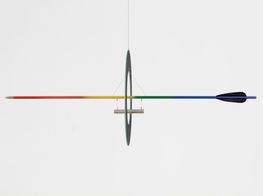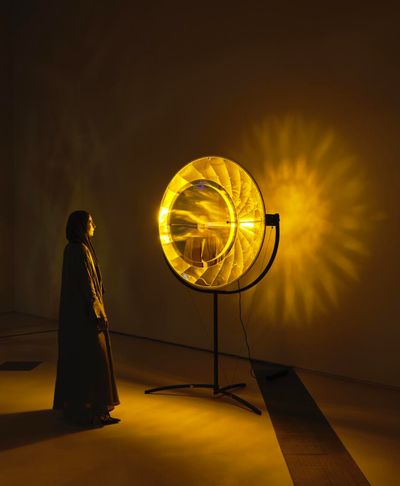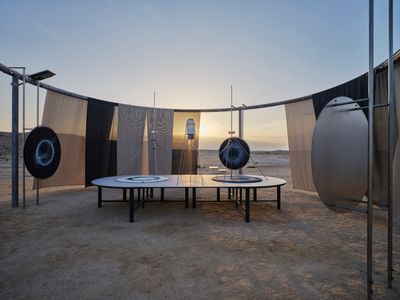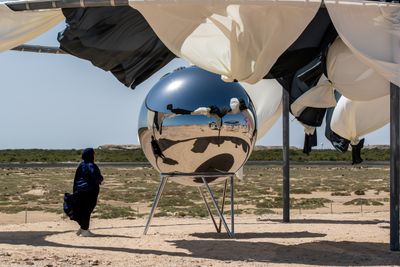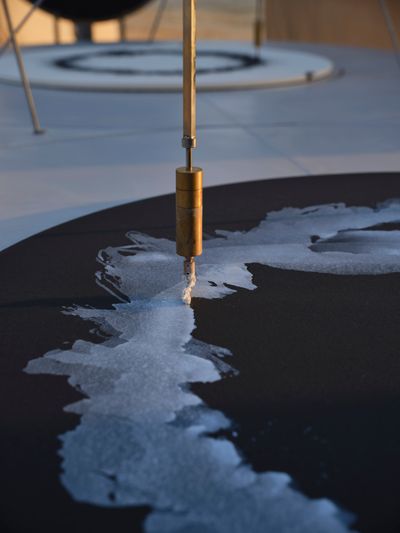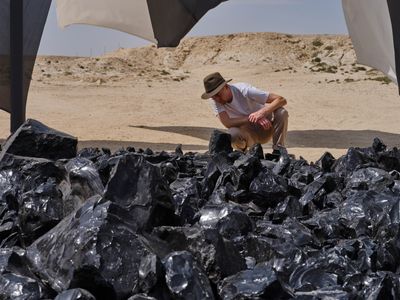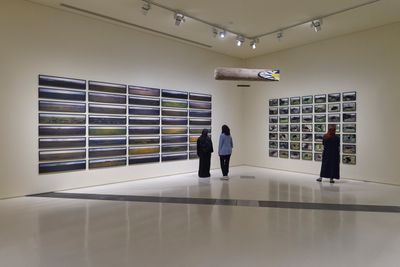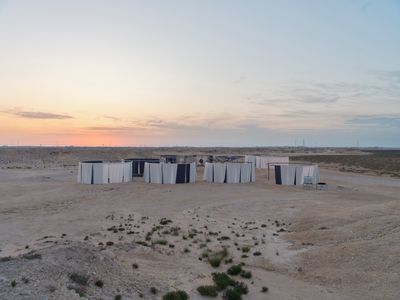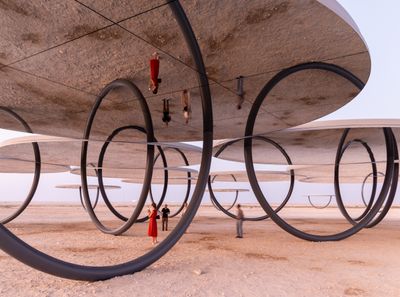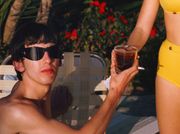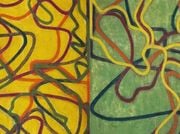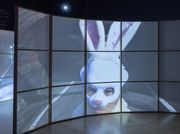Olafur Eliasson on Experiments and Embodied Encounters in the Desert
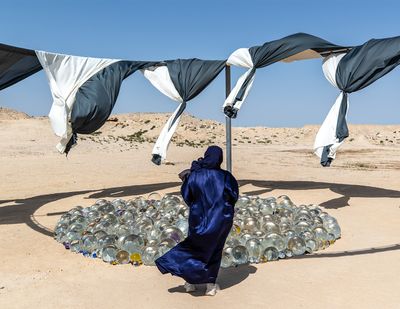
In the desert near the Al Thakhira Mangrove Reserve in north-eastern Qatar, approximately 60 kilometres from Doha, a dozen monumental outdoor installations dot the landscape.
The site-specific 'pavilions', as artist Olafur Eliasson calls them, are part of his solo exhibition The curious desert, presented by the National Museum of Qatar in Doha (19 March–15 August 2023). It is Eliasson's first exhibition in the Gulf region.
Taking place both indoors and outdoors, the show includes what the Danish-Icelandic artist refers to as 'an assembly of embodied thoughts and actions from over 25 years of working as an artist.'
Works on view inside the museum in Doha include expansive light installations, photo series from Iceland, complex geometric studies, watercolours, optical devices, and a sprawling research map.
Appearing like a group of otherworldly science experiments, the 12 outdoor installations in the desert combine—as Eliasson's practice often does—manmade forms with natural elements to highlight ecological issues. Treating the desert like an artistic collaborator, Eliasson has harnessed its forces to co-produce the pieces.
In the installation Rainbow incubator (2023), for example, sunlight bends through a strategic arrangement of glass prisms to create a rainbow; and in Saltwater-drawing observatory (2023), wind moves drawing utensils to drip water onto slowly spinning canvases.
In Solar incense burner (2023), a glass sphere magnifies sunlight to ignite a series of scents characteristic of the region, each of which burns for an hour to mark the passing of the day.
These new site-specific works are in conversation with Eliasson's work Shadows travelling on the sea of the day (2022), which was permanently installed in the desert near the Ain Mohammed heritage site in northern Qatar in 2022.
That installation sees a cluster of mirrored discs held up by free-standing rings, which both provide shelter and reflect the image of viewers and the earth's crust as viewers walk below them. A film accompanying the work is on view at Mohammed Jassim Al Khulaifi Library of the National Museum of Qatar.
In the film, Eliasson explains that he's no stranger to expansive landscapes like the desert. Born in Copenhagen in 1967 to Icelandic parents, he spent much of his childhood exploring the Icelandic terrain. Those vast open spaces impacted the scale of Eliasson's installations; often monumental in size, his most recognised works have transformed entire rooms or landscapes into immersive environments.
The artist combines elements of science, technology, and nature, using light, colour, reflection, and optical devices to explore the relationships between time, perception, and the natural world.
In The weather project, his iconic 2003 installation at London's Tate Modern, Eliasson used mist, hanging mirrors, and yellow light to create the illusion of an enormous glowing sun hovering at the top of the Turbine Hall.
Attracting over two million visitors, the work encouraged viewers to consider society's impact on the climate. The use of artificial light symbolised a dependence on manmade energy, while the mirrored ceiling reflected the visitors below, highlighting humanity's role in the larger ecosystem.
At the heart of each of Eliasson's projects is the aim to draw attention to the urgent need for environmental action. To this end, his Berlin studio often collaborates with architects, engineers, and scientists; in 2012, he created Little Sun, a solar-powered lamp designed to provide a sustainable source of light to people in off-grid areas of the world.
On the occasion of The curious desert, Ocula Magazine spoke with Eliasson about the Qatari landscape, global climate crisis, and making works to reflect context.
EAWhat role does mesmerising viewers play in your conception of artworks? Do you believe being awe-struck can help viewers to imagine new perspectives?
OEI know that the scale of my works might make people think I am interested in creating spectacles but, for me, scale is rather a way to explore embodied experience. I'm interested in how we put our senses to use, in how we use our awareness.
What happens if we become numb to our surroundings? What are the consequences of our actions? I want these environments to invite viewers to be co-producers of their experiences, and to use more than just one sense to explore the artwork.
EAYou've used the phrase 'more than human' when describing relationships or agencies in your works. What does that term mean to you?
OEThe phrase 'more than human', which was coined by ecologist David Abram, encompasses everything that makes up our world‚ human as well as non-human: plants, animals, micro-organisms, the weather, the climate, etcetera. It critiques the idea of human exceptionalism, suggesting that there is more to life on earth than just human activity. I think this idea is incredibly important today, considering the scale of the climate crisis.
My artworks strive to be a continuation of the outside world; to embody transformation rather than stability and stasis.
As biologist Lynn Margulis said: 'Life has existed at the planetary level for at least 3,000 million years... We need to be freed from our species-specific arrogance. No evidence exists that we are "chosen", the unique species for which all the others were made. Nor are we the most important one because we are so numerous, powerful, and dangerous. Our tenacious illusion of special dispensation belies our true status as upright mammalian weeds.'
EAThe curious desert includes series of photographs of Iceland that you selected with Qatar's landscape in mind. How do you consider the connection between those two environments?
OEThe landscapes of Qatar share certain qualities with the Icelandic landscape, although in other respects they may seem to be as different as could be. Both environments might initially appear barren to humans, but on closer inspection they reveal themselves to be intricate ecosystems that are full of life.
The ecologists we worked with on analysing the Al-Thakhira site, for example, observed numerous scorpions and lizards, such as Arnold's fringe-toed lizard and Blanford's short-nosed desert lizard, and many types of birds, including Indian reef herons and common redshanks. They also found a healthy population of Arabian red fox in the area.
The exhibition provides perspectives on the climate crisis on a number of levels.
I was inspired at the prospect of creating works that respond to this landscape. For me, Iceland has always been a site for trying out and exploring artistic ideas—a kind of experimental laboratory, if you will. And this was a key idea for the 12 pavilions I conceived for the sabkha (salt flat) landscape at Al Thakhira: together the works form a laboratory that explores a number of aspects of the site: the wind, the light, the salty water of the nearby lagoon.
EAAs you alluded to, you worked with an ecologist to conduct an extensive survey of the Al-Thakhira site to ensure the protection of its native plants and non-human inhabitants. What were your findings, and did they impact the creation of the 12 works?
OEFor the outdoor site of The curious desert, we worked with ecologist Dr Aspa D. Chatziefthimiou to understand the plants and animal species that live in the area. Under Dr Aspa's guidance, we chose a site that had the least impact on the species living there.
At the end of the exhibition, we will of course ensure we leave things as we found them, but we are also in talks with the Qatar Ministry of Environment and Climate Change to draw up a remediation plan for improving the quality of the site, making it, in fact, more habitable than it was before the artworks arrived.
EAHaving now had multiple survey exhibitions, how do you and your team work with curators to select works from decades of a wide-reaching practice?
OEAll my exhibitions are rooted in a wish to share what feels important at the moment. We, of course, look together at the space, thinking about the exhibition as a kind of journey, with a beginning and an end. The National Museum of Qatar, designed by Jean Nouvel, has this amazing form that is based on the desert rose, and I wanted to respond to that.
I want these environments to invite viewers to be co-producers of their experiences, and to use more than just one sense to explore the artwork.
It's important to me to reflect the existing environment, rather than just place works inside rooms that are somehow disconnected from their situation. When it comes to the selection of artworks, more and more we take into consideration the current location of existing artworks, privileging those that do not need to be brought from far away, to minimise the carbon footprint of transport.
EAYou've described Shadows travelling on the sea of the day as 'a space for visitors to resync with the planet'. What do you hope visitors take away from The curious desert as a whole?
OEThe exhibition provides perspectives on the climate crisis on a number of levels. Some artworks directly address the topic—works like 'The glacier melt' series (1999–2019), for which I documented the shrinking of glaciers in Iceland in a series of aerial photographs taken 20 years apart.
In addition, I hosted two public panel talks at the opening that featured a dynamic, cross-generational discussion. Speakers included the ecologist Dr Aspa D. Chatziefthimiou, representatives from the Ministry of Environment and Climate Change, and the Arab Youth Climate Movement.
Since Shadows travelling on the sea of the day is a permanent work, I wanted to offer visitors an alternative way of encountering it to the commercial experiences that we all know so well—to offer spaces for embodied experience and self-reflection.
These aspects are also central to The curious desert. As a temporary exhibition, it is also constructed around process and transformation. I have long questioned the idea that what is presented inside museums is a simple representation of the outside world. Rather, my artworks strive to be a continuation of the outside world; to embody transformation rather than stability and stasis.
Some of the works at the Al Thakhira desert site, for example, are created over the length of the exhibition. Drawing and painting machines installed in the pavilions respond to the weather and lighting conditions at the site. The abstract circular drawings the machines create are later hung inside the museum as part of the exhibition, showing the processes behind the works from the desert laboratory and ensuring that the exhibition is constantly evolving. —[O]

